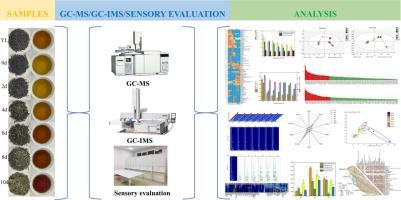Dynamic changes in flavor characteristics of black tea during solid-state fermentation with Eurotium cristatum
IF 8.5
1区 农林科学
Q1 CHEMISTRY, APPLIED
引用次数: 0
Abstract
This study employed GC–MS, GC-IMS, and sensory evaluation to investigate dynamic changes in flavor during the solid-state fermentation of black tea by Eurotium cristatum. The results revealed a notable decrease in the bitter and astringent tastes of the black tea infusion following fermentation, while the mellow taste increased significantly. A total of 152 and 129 VOCs were detected by GC–MS and GC-IMS, respectively. And 4 key aroma-active compounds were identified by ROAV. These specific VOCs contributed floral, honey, and sweet scents, which were responsible for the fungal floral aroma in the processed black tea. Furthermore, OPLS-DA identified 31 key VOCs that played a crucial role in differentiating various fermentation stages, with day 4 recognized as a pivotal point for aroma development. The solid-state fermentation with Eurotium cristatum resulted in fermented black tea characterized by a mellow taste and a rich fungal floral aroma, enhancing the flavor quality of the tea.


红茶在冠突散囊菌固态发酵过程中风味特征的动态变化
本研究采用气相色谱-质谱(GC-MS)、气相色谱-质谱(GC-IMS)和感官评价方法,研究了板蓝根固态发酵红茶过程中风味的动态变化。结果表明,发酵后的红茶苦涩味明显降低,而醇厚味明显增加。GC-MS 和 GC-IMS 分别检测到 152 和 129 种挥发性有机化合物。通过 ROAV 法鉴定出了 4 种关键的香气活性化合物。这些特定的挥发性有机化合物具有花香、蜜香和甜香,是加工红茶中真菌花香的主要成分。此外,OPLS-DA 还鉴定出 31 种关键挥发性有机化合物,它们在区分不同的发酵阶段中起着至关重要的作用,其中第 4 天被认为是香气发展的关键点。采用皱叶桉固态发酵制成的发酵红茶口感醇厚,具有浓郁的真菌花香,提升了红茶的风味品质。
本文章由计算机程序翻译,如有差异,请以英文原文为准。
求助全文
约1分钟内获得全文
求助全文
来源期刊

Food Chemistry
工程技术-食品科技
CiteScore
16.30
自引率
10.20%
发文量
3130
审稿时长
122 days
期刊介绍:
Food Chemistry publishes original research papers dealing with the advancement of the chemistry and biochemistry of foods or the analytical methods/ approach used. All papers should focus on the novelty of the research carried out.
 求助内容:
求助内容: 应助结果提醒方式:
应助结果提醒方式:


